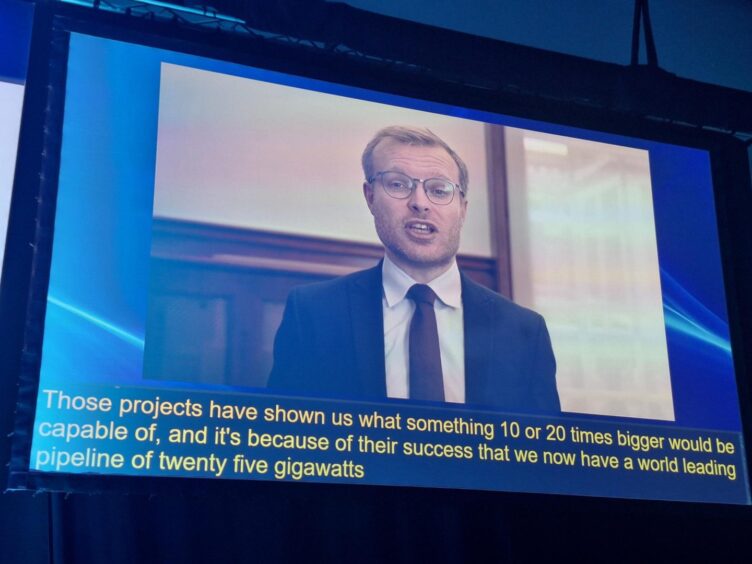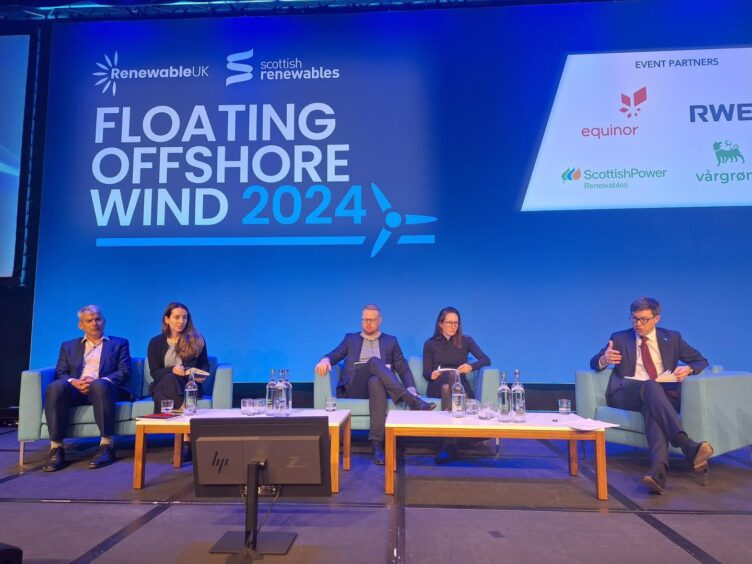
More clarity on GB Energy is “coming soon” a government official promised as the floating offshore wind industry gathered at a conference in Aberdeen and looked for answers.
From a panel session on the second day of the Floating Offshore Wind conference, Scottish National Investment Bank (SNIB) investment director Laura Fidao said more information was needed on the role the UK government’s £8 billion GB Energy would play in the sector alongside other funding and development investors.
She said her organisation, owned by Scottish Government, plays a “very important role in supporting offshore wind, floating offshore wind and the supply chain” but that there was a current lack of clarity how the UK’s various organisations and funding bodies would work together.
She said: “It’s fairly obvious that we do need more information about GB Energy and the National Wealth Fund in particular, those are going to be quite important, especially understanding how they’re going to work alongside us at Scottish National Investment Bank, for example.
“We don’t want to be doubling up on some of the work we’re already doing, but it’s just important to understand how we can complement what these initiatives are going to be doing .”
Susanna Isola, offshore wind investment lead for the Department for Business and Trade (DBT) promised “more clarity is coming soon”.
Speaking on the same panel, she said: “From a UK Government perspective, we’re really keen to work with the whole range of tools, leaders and bodies that we have at our disposal to create the best possible environment for investment, whether it’s the UK Infrastructure Bank and the Scottish infrastructure bank, also UK export finance.
“GB energy and the National World Fund, these were announcements that came before the election.
“You will be hearing this theme from a lot of government officials: We’re very aware that we need to provide more clarity, and more clarity will be provided in the next coming weeks.
“But I think one key message for me is to note that we recognise that a lot of work has been done in this space already.
“We’re keen to draw in that information and add to it and amplify it. We’re not trying to create a new product, ignoring all the work, ignoring all the knowledge that’s been done before.
“So if you haven’t heard about from us, it’s you haven’t heard from us just yet. So yes, more clarity is needed, and more clarity is going to be provided very soon.”
Reach out to funders ‘now’
Fidao identified that SNIB was targeting “new and different” systems and processes needed for floating projects and urged the supply chain to engage with despite some timelines on “moving to the right”.
The bank is also looking at technologies that have “parallels to oil and gas” and “that shouldn’t be forgotten”.
“What’s really important is early engagement with financing parties. This early engagement comes not necessarily from the project developers, it really needs to come from the EPCs, OEMs, tier two, tier three, suppliers with financing parties and with insurance providers, so that we really understand where the risks lie.
“That’s going to facilitate finance. It’s going to make financing for investment quicker, and it has the potential to reduce the cost of capital, which is quite important as well.
“So this is probably the one key message I would give, and especially, things are moving to the right. So there’s more, more time to start this early engagement now.”
Energy minister Michael Shanks, who delivered a recorded address on the second day of the conference said floating offshore wind projects such as Equinor’s (OSE:EQNR) Hywind Scotland and the Kincardine floating projects meant there is now a “world leading pipeline of 25 gigawatts in Scotland”, including the 500MW Green Volt and a further 4.5GW due to be awarded in the Celtic Sea next year.
He said: “Instead of sitting back and toasting those successes while other countries catch up with us, we are determined to keep leading the way to shape the future of this industry and unlock all of that potential.”
He said this was “why we have set up Great British Energy, headquartered in Aberdeen, to work with the private sector to speed up the deployment of clean energy projects like floating offshore wind”.
He added its recently announced partnership with the Crown Estate, which will boost the borrowing powers of the body holding the UK’s royal land holdings, “could deliver up to 20 to 30 gigawatts of extra seabed leases to the market by 2030”.
He added that the UK Government is also working with the Scottish Government and Crown Estate Scotland about “further support for projects in Scotland”.
He said the recently announced Floating Offshore Wind Taskforce, which was unveiled in London on the first day of the conference taking place in Aberdeen, underlined the contribution the sector could make to the economy in the UK and Scotland.
He said: “The new FLOW task force report suggests that this industry could deliver more than £40 billion to our economy by 2050 supporting almost 100,000 jobs.
“That goes right to the core of the Prime Minister’s plan to get Britain building again and owning things, and we’re determined to make the most of the skills and experience of our North Sea workforce as we scale up this industry, whether the welders swapping rigs for huge floating offshore wind sub structures the size of football pitches, or engineers ensuring that all our clean power flows seamlessly across the National Grid.”
Recommended for you


 © Erikka Askeland/DCT Media
© Erikka Askeland/DCT Media